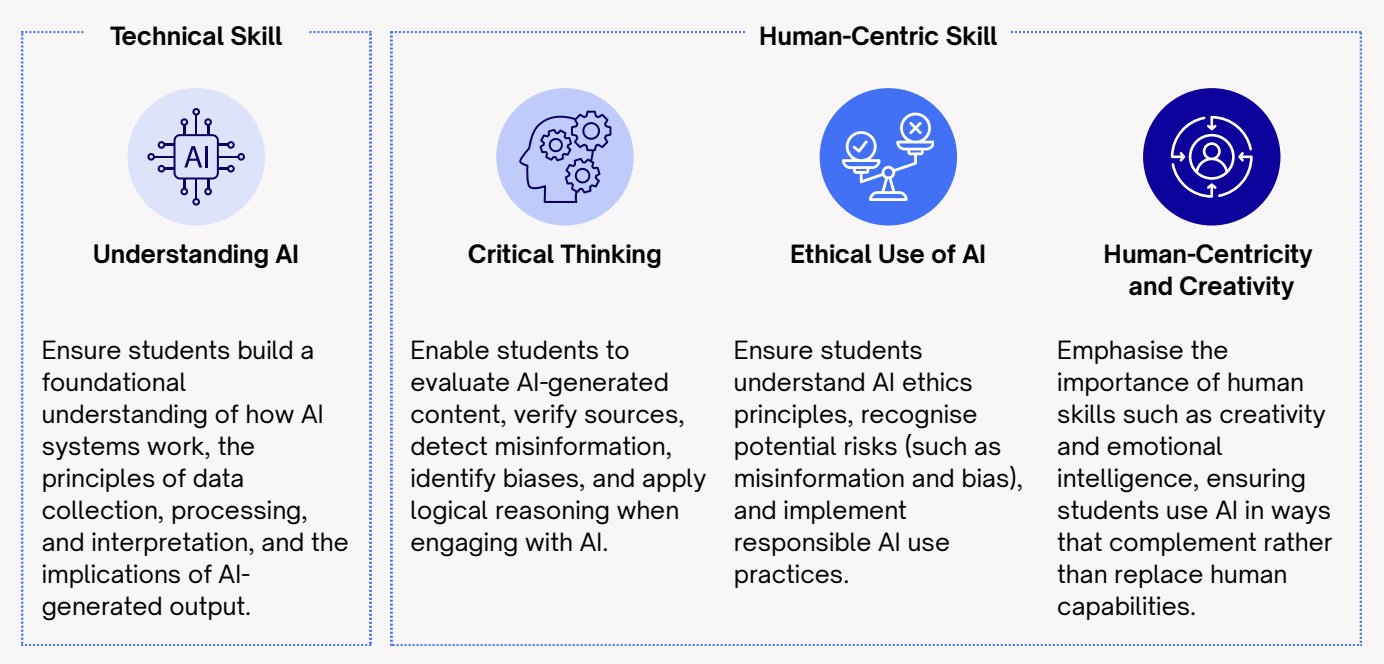AI in education is gaining momentum, with adoption rising among both students and educators.
As AI becomes more embedded in classrooms, it is opening up new opportunities and challenges for educators. Teachers and tutors now face a crucial question: how to integrate AI into curricula and pedagogical practice in a way that enhances student outcomes and graduate employability, while safeguarding critical thinking skills.
While AI is a powerful tool, it will never replace the human element of education: trust-based student-tutor relationships, the fostering of critical skills, and mentorship that inspires intellectual curiosity.
What does it mean to teach with AI?
Teaching with AI means guiding students to use these tools responsibly and ethically, not as a replacement for their own effort but as one of many resources in their learning journey.
It is centered on actively teaching students how to use AI tools effectively, guided by the instructor. The goal is not to let AI teach, but for educators to teach with AI, using it to foster deeper learning and authentic skills.
How are students using AI in education today?
Research suggests that student use of AI for learning is climbing rapidly, with surveys from organizations like the UK’s Higher Education Policy Institute finding double-digit growth between 2024 and 2025.
According to HEPI, although 88% of students have used GenAI in assignments, most are using it ethically to support and supplement their learning. The most popular student uses of AI in learning are:
- Explaining concepts (58%)
- Summarizing articles (48%)
- Suggesting research ideas (41%)
Only 18% use AI-generated text directly in assessments.
While this is reassuring, students flag that they need more support from their institution about how best to approach AI in learning. Plus, research finds disparities in AI confidence by gender, socio-economic background, and ethnicity.
How might AI in education change the role of educators?
As the use of AI in learning grows, the role of educators is changing. While this may feel uncomfortable, daunting, or time-consuming, it is an inevitable evolution.
With appropriate support and strategies from institutional leaders, the evolution of AI in learning can create fulfilling opportunities for educators to develop new professional skills, as well as rebalance their workload in favor of more fulfilling, student-centered activities.
AI should never replace the student-educator relationship – the inspiration, mentoring, and support provided by the people behind the programs. In fact, we believe AI makes that human element more important than ever.
With the growth of AI in learning, instructors may see their function evolving towards becoming:
- Curators: Guiding students to appropriate tools and introduce them to ethical AI use
- Creators: Designing student-centered AI-enabled learning experiences to support AI literacy and workforce readiness
- Coaches: Supporting students to understand AI ethics in education and course-correcting any overreliance
- Champions: Ensuring equitable AI access, to equip students of all backgrounds with essential AI confidence and competence
By embracing the necessary evolution of AI and pedagogy, educators can leverage AI as a tool for deeper learning and intellectual enquiry, guiding students at a time when they need your personal support more than ever.
Why is guiding student AI use imperative for educators?
How educators frame and guide AI use will shape student learning today, and their outcomes and employability later.
Student learning and outcomes
With guidance, AI can help students access tailored support outside of teaching hours, develop their research skills, and sharpen their critical thinking, all contributing to better learning outcomes. Without guidance, the opposite may be true, weakening critical thinking and problem-solving skills, and encouraging only surface-level engagement.
Graduate employability
AI literacy is fast becoming a core professional competency (Forbes). By embedding responsible AI use within the curriculum, institutions prepare students to enter the AI-ready workforce as discerning, proficient, ethical AI users – without undermining other core professional competencies, such as critical thinking and problem-solving.
What strategies can educators use to adapt to teaching with AI?
Teaching with AI is about creating student-centered AI practices that position AI as a tool for learning, within the broader tutor-led context.
A helpful way to frame these strategies is by considering the key skills students need for responsible collaboration with AI. The Digital Education Council’s 2025 report identifies four essential pillars for this kind of skills development:

1. Actively engage with AI in education
The growth in student use of AI in higher education – and demand for graduate AI skills – reinforces that prohibiting AI use is unrealistic and counterproductive.
To support active and considered engagement, educators can introduce AI into their teaching practice, demonstrating how it can be used ethically to enhance research, support brainstorming, test knowledge through practice exercises, provide personalized feedback on student-generated work, and more.
2. Use AI to model critical thinking
While GenAI can produce fast and (mostly) factual responses, it is not perfect – it can generate biased content, hallucinations, and errors. Educators can support students by encouraging them to engage with AI outputs critically.
Consider assignments that require students to assess the validity, accuracy, and limitations of AI outputs. In this way, AI can support the development of critical thinking skills, rather than undermine them.
3. Discuss the ethics of using AI in education
Integrate discussions about AI ethics in education and explain why your institution has the policies it does. Transparent, clearly communicated AI policies help maintain trust and academic integrity while reinforcing the student-instructor relationship.
Discuss the importance of responsible use and academic integrity, both for students’ own intellectual development and in fairness to others. Ask students to consider the outcomes for society and the economy if all students relied on AI to gain professional qualifications.
4. Reinforce learning – not grades – as the objective
Students are under considerable pressure to attain grades and secure graduate roles, which can make AI-enabled shortcuts more attractive. Encourage students to see their education as a process of developing knowledge, skills, and confidence – as we know it is – rather than a race to grading. When students see AI as an aid to authentic learning, they may use it more constructively.
5. Redesign assessments
Consider adapting assessments to reflect the AI landscape and reduce the risk of any AI-enabled misconduct by the few. For example, avoid general topics that can be easily answered by GenAI, instead focusing on specific topics discussed in class.
Of course, education leaders can help to bring these strategies to life – driving the dialogue on constructive AI use, shaping student-centred AI policies, and making provision for faculty to receive any support and training they need.
Championing the human element
While guiding AI in education is an ongoing process, one that will evolve in parallel with the technology itself. By fostering student-centered AI practice and pedagogy, educators can use AI to enhance student and graduate outcomes.
Turnitin is by your side for this latest evolution – and will be for the next – integrating AI tools into our platforms to support both your pedagogical and strategic goals.
From tools that support student learning — like all-new Turnitin Clarity with optional AI assistant — to powerful AI paraphrasing detection tools that guide students towards responsible AI use within their writing.
Discover solutions designed to uphold academic integrity while guiding AI for learning.




